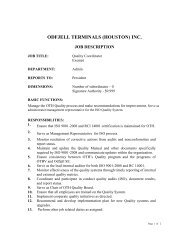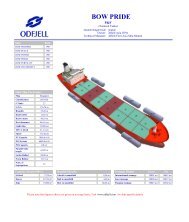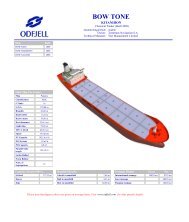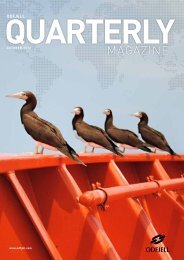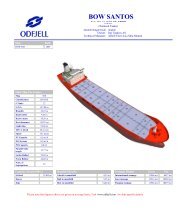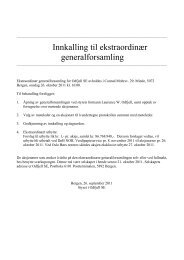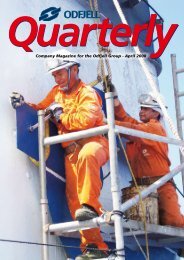Odfjell SE Annual Report 2012
Odfjell SE Annual Report 2012
Odfjell SE Annual Report 2012
Create successful ePaper yourself
Turn your PDF publications into a flip-book with our unique Google optimized e-Paper software.
odfjell group<br />
evaluations. Further details are given in note<br />
2.14 and note 12.<br />
Taxes<br />
The Group is subject to income tax in many<br />
jurisdictions. Considerable judgment must<br />
be exercised to determine income tax for<br />
all countries taken together in the consolidated<br />
accounts. The final tax liability for<br />
many transactions and calculations will be<br />
uncertain. Deferred tax assets are recognised<br />
for all unused tax losses to the extent that<br />
it is probable that taxable profits will be<br />
available against which the losses can be<br />
utilised. Significant management judgment<br />
is required to determine the amount of<br />
deferred tax assets that can be recognised,<br />
based upon the likely timing and level of<br />
future taxable profits together with future<br />
tax planning strategies. Further details are<br />
given in note 2.7.<br />
Pension<br />
The cost of defined benefit pension plans is<br />
determined using actuarial valuations. The<br />
actuarial valuation involves making assumptions<br />
about discount rates, expected rates<br />
of return on assets, future salary increases,<br />
mortality rates and future pension increases.<br />
Due to the long- term nature of these plans,<br />
such estimates are subject to significant uncertainty.<br />
Further details are given in note 2.24.<br />
Provisions<br />
Provisions are based on best estimates.<br />
Provisions are reviewed at each balance<br />
sheet date and the level shall reflect the best<br />
estimate of such possible liability. Further<br />
details are given in note 2.23.<br />
2.4 Changes in accounting principles<br />
and disclosures<br />
<strong>Odfjell</strong> does adopt amendments in standards<br />
and interpretation on continuous basis. In<br />
<strong>2012</strong> the adoption of amendments to standards<br />
and interpretations had no material<br />
impact on <strong>Odfjell</strong>.<br />
2.5 Currency<br />
The consolidated financial statements are<br />
presented in USD as the Group operates<br />
in an international market where the functional<br />
currency is mainly USD. <strong>Odfjell</strong> <strong>SE</strong>’s<br />
functional currency is USD.<br />
The balance sheet of subsidiaries with functional<br />
currency other than USD is translated<br />
at the rate applicable on the balance sheet<br />
date, while the net result is translated using<br />
the monthly average exchange rate for the<br />
accounting period. Exchange rate differences<br />
that arise as a result of this are included as<br />
exchange rate differences in other comprehensive<br />
income. When a foreign subsidiary is<br />
sold, the accumulated translation adjustment<br />
related to that subsidiary is included in net<br />
result.<br />
2.6 Revenue recognition<br />
Revenue is recognised when it is probable<br />
that a transaction will generate a future<br />
economic benefit that will accrue to the<br />
Company, and the size of the amount may<br />
be reliably estimated. Revenue is measured<br />
at the fair value of the amount to be received,<br />
excluding discounts, sales taxes or duty.<br />
Total revenues and voyage related expenses<br />
in a period are accounted for as the percentage<br />
of completed voyages. Voyage accounting<br />
consists of actual figures for completed<br />
voyages and estimates for voyages in<br />
progress. Voyages are normally dischargeto-discharge.<br />
Except for any period a ship is<br />
declared off-hire due to technical or other<br />
owner’s matters, a ship is always allocated<br />
to a voyage.<br />
Tank rental income is recognised to the<br />
extent that it seems likely that the economic<br />
benefits will accrue and the amount may be<br />
reliably measured. Distillation income and<br />
other services are recognised in proportion<br />
to the stage of the rendered performance<br />
as at the balance sheet date. If the income<br />
from rendering of services can not be reliably<br />
measured, only the income up to the<br />
level of the expenses to be claimed will be<br />
recognized.<br />
2.7 Taxes<br />
The shipping activities are operated in several<br />
countries and under different tax schemes,<br />
including the ordinary tax system in Norway,<br />
the Norwegian shipping tax system, the<br />
Approved International Shipping system in<br />
Singapore and the tonnage tax systems in<br />
the UK. In addition we operate under local tax<br />
systems, most important in Chile and Brazil.<br />
Our tank terminal activities are generally<br />
subject to the ordinary corporate tax rates<br />
within the country in which the terminal is<br />
located. The variation in the tax systems and<br />
rates may cause tax costs or income to vary<br />
significantly depending on the country in<br />
which profits and losses are accumulated.<br />
The Group’s taxes include taxes of Group<br />
companies based on taxable profit for the<br />
relevant financial period, together with tax<br />
adjustments for previous periods and any<br />
change in deferred taxes. Tax credits arising<br />
from subsidiaries’ distribution of dividends<br />
are in some circumstances deducted from<br />
payable taxes in other jurisdictions to avoid<br />
double taxation.<br />
Deferred income tax liabilities are recognised<br />
for all taxable temporary differences, except:<br />
• where the deferred income tax liability<br />
arises from the initial recognition of goodwill<br />
or of an asset or liability in a transaction<br />
that is not a business combination and, at<br />
the time of the transaction, affects neither<br />
the accounting profit nor taxable profit or<br />
loss; and<br />
• in respect of taxable temporary differences<br />
associated with investments in<br />
subsidiaries, associates and interests in<br />
joint ventures, where the timing of the<br />
reversal of the temporary differences can<br />
be controlled and it is probable that the<br />
temporary differences will not reverse in<br />
the foreseeable future.<br />
Deferred tax assets are recognised to the<br />
extent that it is probable that future taxable<br />
profit will be available to offset the temporary<br />
differences. We recognise formerly unrecognised<br />
deferred tax assets to the extent that it<br />
has become probable that we can utilise the<br />
deferred tax asset. Similarly, the Company<br />
will reduce its deferred tax assets to the<br />
extent that it no longer can utilise these.<br />
Deferred tax and deferred tax assets for the<br />
current and prior periods are measured at the<br />
amount expected to be paid to or recovered<br />
from the relevant tax authorities, using the<br />
tax rates and tax laws that have been enacted<br />
or substantively enacted at the balance sheet<br />
date. Deferred tax and deferred tax assets<br />
are recognised irrespective of when the<br />
differences will be reversed. Deferred tax<br />
and deferred tax assets are recognised at<br />
their nominal value and are classified as<br />
non-current liabilities (non-current assets)<br />
in the balance sheet.<br />
Companies taxed under special shipping tax<br />
systems will generally not be taxed on the<br />
basis of their net operating profit. A portion of<br />
net financial income and other non-shipping<br />
activities are normally taxed at the ordinary<br />
applicable tax rate. Taxation under shipping<br />
tax regimes requires compliance with certain<br />
requirements, and breach of such requirements<br />
may lead to a forced exit of the regime.<br />
Tax payable and deferred taxes are recognised<br />
directly in equity to the extent that<br />
they relate to factors that are recognised<br />
directly in equity.<br />
23<br />
odfjell annual report <strong>2012</strong>




